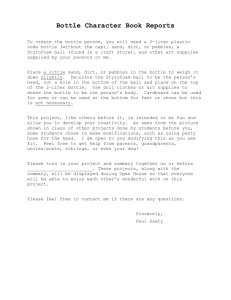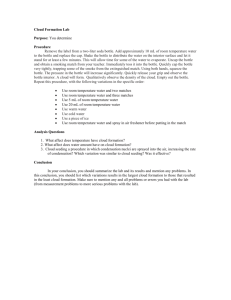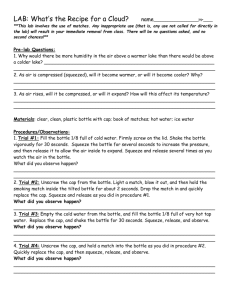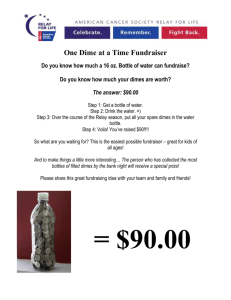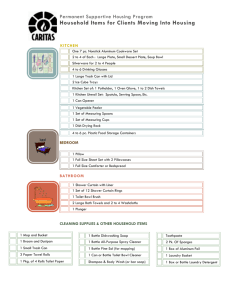"Cloud-in-a-Bottle" Experiment
advertisement
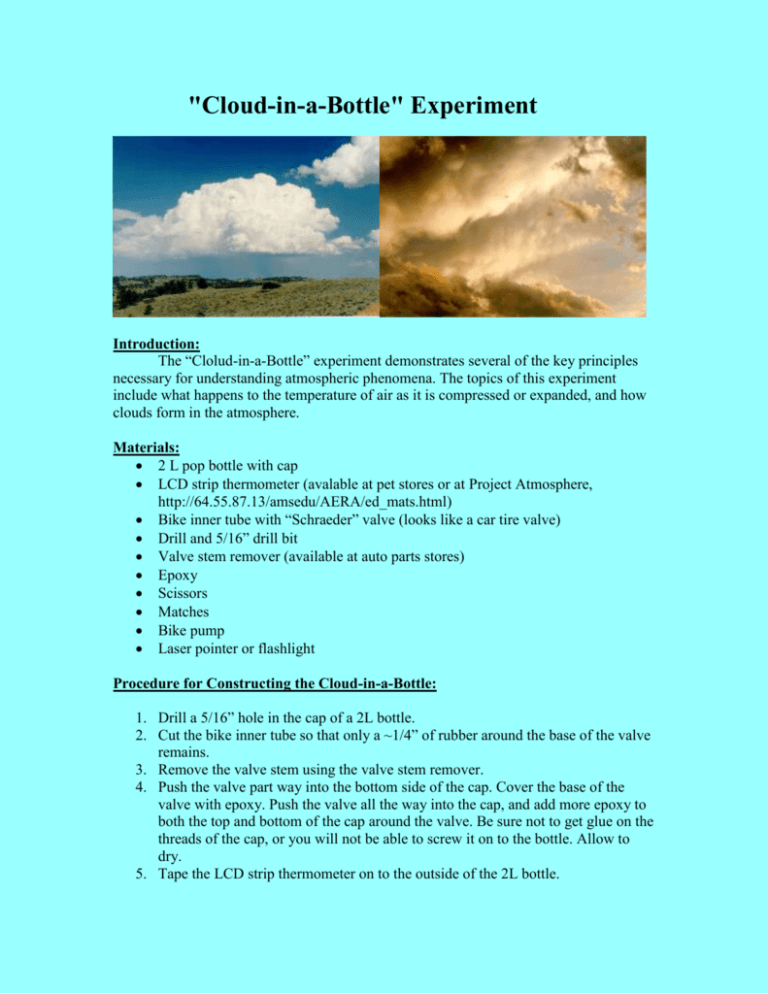
"Cloud-in-a-Bottle" Experiment Introduction: The “Clolud-in-a-Bottle” experiment demonstrates several of the key principles necessary for understanding atmospheric phenomena. The topics of this experiment include what happens to the temperature of air as it is compressed or expanded, and how clouds form in the atmosphere. Materials: 2 L pop bottle with cap LCD strip thermometer (avalable at pet stores or at Project Atmosphere, http://64.55.87.13/amsedu/AERA/ed_mats.html) Bike inner tube with “Schraeder” valve (looks like a car tire valve) Drill and 5/16” drill bit Valve stem remover (available at auto parts stores) Epoxy Scissors Matches Bike pump Laser pointer or flashlight Procedure for Constructing the Cloud-in-a-Bottle: 1. Drill a 5/16” hole in the cap of a 2L bottle. 2. Cut the bike inner tube so that only a ~1/4” of rubber around the base of the valve remains. 3. Remove the valve stem using the valve stem remover. 4. Push the valve part way into the bottom side of the cap. Cover the base of the valve with epoxy. Push the valve all the way into the cap, and add more epoxy to both the top and bottom of the cap around the valve. Be sure not to get glue on the threads of the cap, or you will not be able to screw it on to the bottle. Allow to dry. 5. Tape the LCD strip thermometer on to the outside of the 2L bottle. Experiments A. Air Pressure and Temperature Relationships: Pour about an inch of water into the bottle, cap it, and read the temperature of the air inside the bottle as indicated by the temperature strip. Attach the bike pump to the valve, and pump up the bottle to about 30 psi. Observe what happens to the temperature of the air in the bottle. After a minute or so, release the pressure by removing the bike pump. Observe what happens to the temperature when the pressure drops. Questions: 1. What happened to the air temperature as a result of the air being compressed? 2. When you lowered the pressure in the bottle by removing the bike pump, what happened to the air temperature? 3. State, in your own words, the relationship between changes in air pressure and temperature. B. Making Clouds Appear and Disappear: Now twist the bottle to wet the inner surface. Let it stand for a couple of minutes so the air inside can become saturated. Light a match and drop it into the water. The smoke is made of tiny particles that provide a surface on which the water vapor in the bottle can condense to form a cloud. Dim the lights if possible, and pressurize the bottle again to about 30 psi using the bike pump. Note the temperature. After a minute or so, shine the laser pointer or flashlight into the bottle, and release the pressure. You should see a cloud appear. Note the temperature. Now pump the bottle up again, and observe what happens. Questions: 1. Did the cloud form when you applied pressure or when you released pressure? Did it form when temperatures rose or when they fell? 2. What happened when you pumped up the bottle after making the cloud? Why did this happen? 3. Experiments A and B are almost the exactly the same. Why did a cloud form in experiment B and not in experiment A? A Few Links: This document online: http://atoc.colorado.edu/~seand/cloud.html (.html) http://atoc.colorado.edu/~seand/cloud.doc (.doc) NOAA Education Weather Links: http://www.education.noaa.gov/tweather.html Activities in Meteorology: www.fsl.noaa.gov/visitors/education/sam1/SAM_Intro.html Wikipedia : http://en.wikipedia.org/wiki/Cloud



